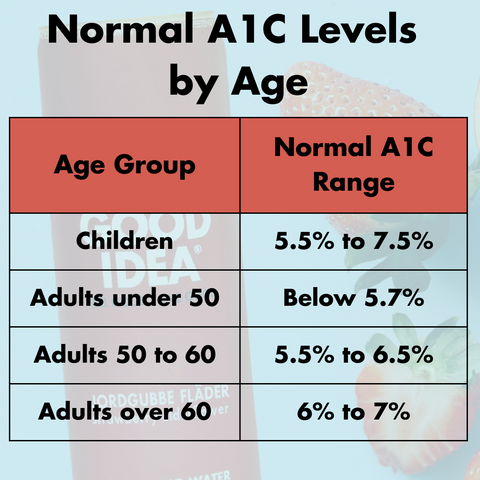The Complete Guide to A1C

🎧 On the go? Listen to this episode on The GOOD IDEA Audio Blog, available on Shopify (link below) or Apple Podcasts.
If you or someone you know has diabetes, you've probably heard the term "A1C" before. But what is A1C? A1C, also known as HbA1c, is a blood test that measures the average level of blood sugar (glucose) over the past three months. It is a measure used as a means to diagnose and manage diabetes. In this complete guide to A1C, we'll cover everything you need to know about this important test, including how to test A1C, what a normal A1C level is, how to lower your A1C, and more.
What Does an A1C Test Measure?

The A1C test, also known as the glycated hemoglobin test, is a blood test used to diagnose and manage diabetes. This test measures the average blood sugar levels over the previous three months by analyzing the amount of glycated hemoglobin in the blood.
When we eat, our bodies break down carbohydrates into glucose, which then enters the bloodstream. The hormone insulin helps move glucose from the bloodstream into our cells, where it can be used for energy. If our bodies do not produce enough insulin (like in Type 1 Diabetes) or do not use it properly (as is the case with those who are insulin-resistant), glucose accumulates in the bloodstream, leading to high blood sugar levels. Over time, high blood sugar levels can cause damage to organs and tissues in the body, increasing the risk of complications such as heart disease, kidney damage, and nerve damage.
As glucose circulates in the bloodstream, some of it binds to hemoglobin, a protein found in red blood cells. This process is called glycation. The more glucose in the bloodstream, the more hemoglobin becomes glycated. By measuring the amount of glycated hemoglobin in the blood, the A1C test provides an estimate of the average blood sugar levels over the previous three months.
How can Doctors use an A1C Test to Improve our Health?

The A1C test is a valuable tool for managing diabetes because it provides a long-term picture of blood sugar control, rather than a snapshot of a single moment in time. A1C levels can help healthcare providers determine whether a patient's diabetes treatment plan is effective, and make adjustments as needed. For example, a patient with an A1C level above the target range may need to adjust their diet, exercise routine, or medication regimen.
In addition to being used to diagnose and manage diabetes, the A1C test can also be used to screen for prediabetes, a condition in which blood sugar levels are higher than normal but not high enough to be classified as diabetes. The American Diabetes Association recommends that adults be screened for diabetes every three years starting at age 45, or earlier if they have risk factors such as being overweight or having a family history of diabetes.
Who Should get an A1C Test, and When?

The American Diabetes Association recommends that people with diabetes have an A1C test at least twice a year, and more often if their blood sugar levels are not well controlled.
In addition to people with diabetes, the following groups of people should consider getting an A1C test:
- People who are overweight or obese
- People who have a family history of diabetes
- People who have high blood pressure or high cholesterol levels
- Women who had gestational diabetes during pregnancy
- People who have been diagnosed with prediabetes
- People who have a history of heart disease
The timing of the A1C test may vary depending on individual circumstances. It is best to talk to a healthcare provider to determine when you should get an A1C test based on your medical history and current health status.
How to Test A1C
To test A1C, a healthcare provider takes a small blood sample, usually from a vein in your arm. The test does not require any special preparations or fasting. You can have it done at any time of day. Results are usually available within a few days and will be reported as a percentage.
What is a Normal A1C?
A1C levels are reported as a percentage. A target A1C range varies based upon age, sex, and health history. The normal A1C range for most healthy individuals is between 4% and 5.6%. This percentage represents the amount of hemoglobin in your blood that is saturated with sugar (aka glycated). Thus, for a healthy individual, an A1C of 4% means that 4% of the hemoglobin in your blood is saturated with sugar.
For healthy adults, a normal A1C level is below 5.7%, an A1C between 5.7 and 6.4% is considered prediabetes, and diabetes is diagnosed with an A1C of 6.5% or above.
Here is a chart that lists normal A1C levels by age:

For those with diabetes, the A1C goal may vary based on individual circumstances, but generally, the goal is to decrease below 7%. It is best to speak with your healthcare professional to determine what is the best goal for you. In general, here is a chart that lists A1C goals by age:

While these percentages may seem abstract, you don’t have to wait three months to see if your A1C goals are on track. You can equate A1C percentages to the same numbers you are used to seeing on your blood glucose meter. Here is a chart that lists the A1C percentage with the associated reading on your glucometer.

Pros and Cons of A1C Measurements
A1C measurements are a useful tool for managing diabetes, but like any medical test, they have both pros and cons. Here are the pros and cons of A1C measurements:
Benefits of A1C Tests:
- A1C measurements provide a long-term view of blood glucose levels. Unlike a fingerstick test, which only measures blood glucose at one point in time, an A1C test measures average blood glucose levels over the past 3 months.
- A1C measurements are easy to obtain. Unlike other diabetes tests, such as a glucose tolerance test, an A1C test only requires a simple blood draw.
- A1C measurements can help in early detection and diagnosis of diabetes. By identifying high A1C levels, doctors can diagnose diabetes early, sometimes even before symptoms appear.
- A1C measurements can help in monitoring the effectiveness of diabetes treatments. By tracking A1C levels over time, doctors can see if treatments are working and make adjustments if necessary.
Disadvantages of A1C Tests:

- A1C measurements may not be as accurate in certain situations. For example, people with certain medical conditions, such as sickle cell anemia or kidney disease, may have inaccurate A1C results.
- A1C measurements do not provide immediate feedback. Unlike a glucometer or a continuous glucose monitor (CGM), which provide instant results, an A1C test requires a blood draw and lab analysis, which can take several days.
- A1C measurements do not provide information about blood glucose fluctuations. While A1C measurements provide an average blood glucose level over time, they do not provide information about daily fluctuations in blood glucose levels.
It is important to remember that A1C is just one of the tools that are available to manage diabetes. The daily fluctuations in blood sugar are not captured by A1C numbers, so continuing to monitor daily blood sugar is still an important part of diabetes management.
Factors that Impact Your A1C
The following medical conditions or circumstances can impact your A1C results.
- Kidney failure
- Liver disease
- Severe anemia
- Pregnancy
- Certain medications like opioids or HIV medications
- Blood loss and blood transfusions
How to Lower Your A1C
In order to lower your A1C we need to lower your average blood glucose readings. This entails minimizing glucose fluctuations and stabilizing your blood sugar. The great news is that regulating your blood sugar will not only help to lower your A1C quickly, it will also help to sustain your energy levels throughout the day (say goodbye to the afternoon fatigue), help to stabilize your mood and improve your metabolic health. For those with diabetes, lowering A1C levels can help to reduce the risk of complications and improve overall health. Here are 6 tips that we can use to lower your A1C levels naturally.

- Add Protein- Making a few small adjustments to your diet can result in massive blood sugar benefits. Start by adding some protein to your meals. When we add protein to our carbohydrates, it blunts the blood sugar spike that would traditionally accompany the carbohydrates. Shoot for 20-30 g of protein at each meal.
- Add Soluble Fiber- Fiber, especially soluble fiber, is a great way to help stabilize blood sugar. Since fiber is not able to be digested by our gut, it passes directly through the digestive system, does not spike our blood sugar, and does not require insulin to be digested. As if that isn’t enough of a reason to eat fiber, it can also help us to feel full for longer, lower cholesterol, and improve digestion.
- Order Your Meals- The body processes food in the order in which our food is received. By consuming our food in a specific order we can mitigate a carbohydrate-induced blood sugar spike. Consume fiber (like a salad), proteins, and/or healthy fats before carbohydrates for the best blood sugar results.
-
Increase physical activity- Exercise, even just a few minutes, is an important aspect of blood sugar control. When we use our muscles, the body pulls blood sugar out of circulation and
uses it as fuel to power those working muscles. Start small with a 15-minute walk after lunch. That walk will help to stabilize blood sugar. As your physical abilities progress, incorporate some high-intensity interval training (aka HIIT). HIIT improves blood sugar control, increases insulin sensitivity, and helps us to achieve our weight loss goals. Mix up your exercise routines by grabbing a friend or join a group exercise class to help keep yourself accountable to your health goals and make it enjoyable.

- Reduce Stress- Stress can increase the release of stress hormones that raise blood sugar levels and decrease insulin sensitivity. Deep breathing exercises, physical activity, or relaxing social time are great ways to help reduce stress.
- Track your blood sugar- Keeping track of your blood sugar changes throughout the day can help to assure you that you are on the right path. A continuous glucose monitor (CGM) or glucometer can be valuable tools to assure that you meet your A1C goals at your next doctor's visit. You can get a CGM with Tastermonial or a glucometer with BioCoach or KetoMojo.
It is important to work with your healthcare provider to develop an individualized treatment plan that includes medication if needed.
Conclusion
A1C is a critical measure of blood sugar control that is used to diagnose and manage diabetes. By understanding what A1C is, how to test it, and what is considered a normal range, individuals who may be at risk of developing diabetes or those with diabetes can take steps to manage their blood sugar and reduce the risk of complications. With a few lifestyle changes, it is possible to lower A1C levels and improve overall health.
Author: Dr. Colleen Gulick



